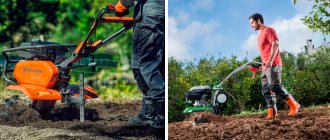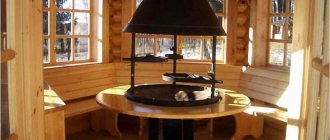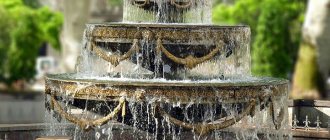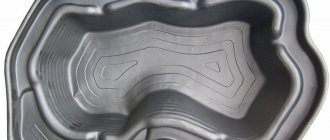A tastefully decorated and impeccably landscaped plot of land gives visual pleasure and restores strength. Cozy country corners with artificial ponds, cascading waterfalls, and enchanting fountains offer a special degree of relaxation.
To organize them, you will need specific pumping equipment, the installation and operation rules of which are worth familiarizing yourself with. Do you agree?
You will find all the most valuable and useful information about pumps for fountains and waterfalls on our website. We provide clear guidelines to help you choose the most suitable model with the necessary technical data.
Those who want to independently build a pond with special effects near a country house will find practical recommendations and diagrams for implementing an amazing idea.
We will describe the types of pumping equipment used in landscape design, give examples of construction and outline the nuances of installing equipment. An excellent addition to carefully selected and systematized information are collections of photos, graphic diagrams and videos.
Types of pumping equipment
Circulation pumps for artificial reservoirs are divided into two main types: submersible and surface. Submersibles carry out their work directly at the bottom of the reservoir. Surface ones are installed near the shore, so they do not come into contact with water.
Characteristics of submersible models
When talking about submersible pumps, the first thing we need to mention is the relatively easy installation method. Such devices are used mainly in the construction of small fountains not exceeding a height of 2 m.
The submersible device is completely submerged in water. The upper element acts as a liquid sprayer, which then returns back to the reservoir
To ensure proper operation, it is recommended that the pump be installed using additional components. This number includes all kinds of substrates and frames that prevent sand and silt from getting into the mechanism of the device. In most cases, ordinary bricks are used, from which a kind of pedestal is constructed.
The pump draws water from the lower layers of the reservoir and then releases it through the nozzle. The stream is sprayed directly above the unit, but when a hose is connected to the device, it can be brought to the location specified by the landscaping idea.
The two elements are connected using a plastic or rubber tube. Often the length of the pipe is dictated by the power of the pump. The greater the distance between the modules, the more intense the flow should be. The pipes are connected and extended using a telescopic principle.
It should be remembered that the pressure in the pumping system largely depends on the cross-section of pipes and supply hoses. The narrower they are, the greater the flow density at the outlet will be, therefore, the more intense the jet.
Like any automatic system, the submersible pump operates from an electrical network. According to the basic installation rules, the system must be grounded.
A voltage of 24 V is sufficient for it to operate. Devices of this type are low-voltage, so the power source can be a regular transformer.
The situation is completely different with high-power devices. As the number of tubes increases and additional structures are connected, more energy is required. Consequently, such systems are connected directly to the network using an electrical cable.
To avoid emergency situations, the power harness must be covered with waterproof material.
The mechanical cleaning filter is a fine mesh made of stainless steel. It traps mechanical contaminants, preserving the internal parts of the water pump (+)
An important factor is the presence of sand particles and other pollutants in the water of reservoirs. Most submersible systems for wells or fountains are designed to pump almost pure water.
A number of models allow the presence of impurities in water in a volume of 50 g/m³ and large particles whose size does not exceed 0.2 mm. To prevent breakdowns, each pump is equipped with a filtration system, which is included in the design of the primary module located under water.
The technical documentation attached to the submersible pumping units indicates the permissible range for the acidity index of water, salinity and the maximum possible temperature for pumping. The manufacturer's instructions must be scrupulously followed so that the pump does not fail ahead of schedule.
The motors of submersible pumps are continuously cooled during operation by the pumped water. The design of the equipment provides for maintaining thermal equilibrium and protecting contacting parts from premature abrasion.
The pump must be selected so that the operation process is carried out at medium speeds, while achieving the desired power level. If the pump is constantly working at full capacity, the working life of the unit will end faster. In this case, it is advisable to replace the equipment with a more productive one.
Another advantage of submersible pumping devices is the quietness of the mechanism. Because The main noise generator is underwater and is practically inaudible from the shore. Also, the device's power consumption is relatively low, which increases the degree of savings.
If repairs are necessary, the submersible device must be turned off and removed from the reservoir. Simple repair operations can be carried out without any problems by yourself.
Submersible pumps are used both in the construction of fountains and in the construction of waterfalls. A significant disadvantage is the demands on water characteristics, which significantly limit the scope of application (+)
Description of surface systems
For the construction of multi-level structures, surface pumps are mainly used. The ease of use of this type of equipment lies in its ease of maintenance. Compared to its submersible counterpart, it is much easier to detect a breakdown and repair it if necessary.
Surface pumps are less sensitive to contaminants, suspended clay and organic matter in the water. They are capable of pumping water from open, undeveloped reservoirs without causing damage to their own mechanics. Equipment that is resistant to minor impurities in water also includes drainage pumps.
To draw water into a pond or fountain container, only the hose attached to the inlet pipe is lowered. If the water intended for pumping is excessively contaminated, it is advisable to equip the hose with a bottom valve with a fine filter mesh.
According to the diagram, the multi-stage fountain design is mainly characteristic of small bodies of water. The outlet of each subsequent level is smaller than the previous one. This is dictated by the need to conserve power (+)
Disadvantages include poor resistance to moisture and overheating from direct sunlight. To maintain high-quality performance, the device should not be left in the open air.
Manufacturers recommend constructing separate boxes or small pavilions for such equipment that will protect it from precipitation.
The surface pump must be protected from direct exposure to UV, overheating and precipitation. It cannot be installed in open areas; it is advisable to build a box or soundproof box for the pump
A significant disadvantage of surface pumping systems is the high noise level. Since the equipment is not under water, its operation is clearly audible to others. To avoid such situations, it is advisable to line the inside of the protective housing or pavilion with noise-absorbing material.
The power of the device directly depends on the distance to the reservoir. If you connect too long hoses and all kinds of attachments to the surface pump, the efficiency of the device will significantly decrease.
Therefore, manufacturers insist on installing equipment in close proximity to a reservoir and indicate the maximum permissible distance for its operation.
The distance to the reservoir does not exceed 2 m. Two compressors are connected to the device at once, which increases the intensity of the pressure
Often two objects are connected to such a system at once: a fountain and a waterfall. According to the instructions, the water pressure for these elements should be different. It follows from this that when branching a water supply and connecting two hoses, you need to correctly adjust the flow power level.
To be able to connect two circuits to one pumping device, it is advisable to purchase a tee if it was not included in the original factory configuration.
It is important to understand this before the installation process, because it often happens that the characteristics of the device become a complete discovery after the discovery of inoperability. It is better to carefully familiarize yourself with the technical data of the pump in advance, and then proceed with installation.
Briefly about the main thing
A picturesque pond with a waterfall is the decoration of any site and the pride of its owners. To make flowing water pleasing to the eye, you will need to establish its circulation, and here you cannot do without a pump.
For uninterrupted operation, you will need a unit that can pump contaminated water. A model of both submersible and surface type is suitable for this role, each with its own operating features and characteristics.
To choose the right pump, take into account the size of the reservoir and the parameters of the waterfall (height and width of the jet), power (performance) and pressure of the device. It should also be remembered that the power decreases if a filter is connected or the length of the water supply hoses is increased.
Technical features of devices
In most cases, landscape designers use a pump for fountains or waterfalls, but there are also decorative complexes. This is typical for design ideas that emphasize the special style of the landscape.
Architectural compositions in the form of mermaids, corals and other marine-themed elements are often used as the final module of a water pressure system. For this purpose, there are special models of pumps that do a good job of supplying water.
Waterfalls can come in all shapes and sizes. The most common option is stylization to resemble natural objects, for example, a slide of river stones (+)
To add variety to the fountain, most manufacturers include several nozzles in the water unit kit that change the shape of the jet.
Filtering qualities are undoubtedly important for the proper operation of the system, but for the most part they do not provide bactericidal properties. Some fountains have this feature.
The effect is achieved thanks to hardware components, namely ultraviolet lamps. Systems with a cleaning module for removing microorganisms and their metabolic products are correspondingly more expensive.
As a result, the percentage of microbes causing water blooms has significantly decreased. Plus, ultraviolet radiation will have a beneficial effect on the fauna of the reservoir if you plan to breed river animals, for example, fry.
These properties are inherent, for example, in the Gardena FFP5000 . The disinfecting effect is fully felt only in reservoirs with a volume of up to 5000 liters. If the tank exceeds the recommended capacity, you need to install another model with a more powerful UV lamp - Gardena PF 15000S .
In addition, the decorative aspect of the fountain requires the presence of a special recess in the upper part of the sprinkler. The cavity can be filled with any material, be it crushed stone or other granulate. This design will fit well into a country house interior.
The popularity of the equipment is mainly explained by the relatively low price, and due to the small size of the unit, there will be no difficulties during its installation.
A large number of attachments will help create the desired atmosphere in your summer cottage. Today, the water pump package includes several nozzles
If a waterfall is planned on the site, it is better to use units that can pump dirty water. Such a device is not afraid of pollution and inclusions found in open natural reservoirs. Large fragments of algae, leaves, etc. will not disable them at all.
Therefore, to take water from natural sources, it is recommended to buy a surface pumping station, and to work in indoor pools and artificial ponds with pumped tap water, it is recommended to buy submersible ones.
BUY A PUMP FOR A FOUNTAIN – FROM ECONOMY TO PREMIUM
Today, several dozen manufacturers from all over the world offer to buy a pump for a fountain, waterfall, stream or cascade. Pond equipment differs in power, performance, functionality and cost. Some brands rely on power and advanced equipment, while others rely on affordable prices. Each summer resident also makes his own choice: to buy an economy fountain pump or top-class equipment?
We will not say that expensive premium fountain pumps are always better. In some cases, their purchase is impractical - for example, when the size of a decorative pond is small. There is no point in raising the stream of water 8-10 meters here. Therefore, we advise you to buy a pump for a fountain taking into account the required parameters, not always focusing on cost. We have been working with the Oase and Pondtech brands for a long time. These manufacturers have a huge selection of models of different modifications and price categories.
From the budget line we offer to buy a pump for the Pondtech fountain of the FF-AP series for small reservoirs. The German company Oase also has a range of inexpensive Aquarius Universal Classic pumps. They can be installed both in water and on land. The middle price category is the Oase Aquarius Fountain Set. The brand also has a premium line. These are the most powerful all-season pumps AquaMax Expert. If you do not want to dismantle the equipment for the winter, then it is better to buy a pump for the fountain of this series with frost protection.
Guidelines for a thoughtful device purchase
The primary factors affecting the cost are the type of fountain and its power. Submersible equipment is usually more expensive than surface equipment, because in its manufacture, specific materials are used that are resistant to underwater pressure and constant contact with the not always harmless aquatic environment.
Surface pumps for constructing decorative waterfalls and fountains are suitable if water is drawn from open natural reservoirs
Manufacturers often include certain extras in the package. The presence of various modules and attachments is determined by the specific model of the unit. Visual effects that affect the price include the presence of backlighting and an ultraviolet emitter.
All of the above, of course, can affect the cost, but the main price range depends on the name of the manufacturer and the dimensions of the purchased fountain.
Variations of backlights are different. Manufacturers mainly provide the ability to switch a specific color using the remote control.
In order to optimize the choice of pump as much as possible and correctly evaluate the proposed functions from a practical point of view, you should be guided by a number of points.
Checklist for purchase:
- First of all, choose a device with a full set of additional extensions. This includes nozzles and hoses, a water flow control system, and several spray heads.
- Correctly match the size of the pool with the power of the unit.
- When organizing a multi-level fountain or waterfall, surface-type water installations show the best performance.
- High-quality models are resistant to corrosion. This should not be neglected, since the device is always in or near water. The correct choice of protective coating will significantly extend the life of the equipment.
- Always ask for the instrument's documentation. Make sure that the documents are authentic and that quality certificates are available.
- Pay attention to warranty features. Review the purchase agreement for service warranty clauses.
- When connecting the power supply, make sure that the system is equipped with a special fuse that can stop the current supply at any time. This is not a joke, because accidents often occur due to the violation of the hermetic sheath of power cables.
By observing all this, you are guaranteed to receive a high-quality product that will serve well for many years. Water fountain compressors come in a variety of shapes and sizes, and manufacturers are constantly making adjustments to the equipment, making it even more reliable.
How to calculate productivity
The wider the waterfall, the more powerful the pump will be required. You can more accurately determine which model you should choose after calculating the following characteristics:
- Flow of water. To calculate the flow, multiply 1.5 l/min by every 10 mm of flow width.
- Performance. Find by the formula: K*W*24*60, where W is the width of the jet, and K is the coefficient. For a slow flow K=5, for a medium flow – 10, for a stormy flow – 15.
Thus, if equipment is needed for a large pond with a cascading waterfall, where the water will rise 4 m in height, a pump with a capacity of 6000 l/hour and a design pressure of 4.2 m is suitable.
For an average pond, a unit with a capacity of 3000-4000 l/hour is suitable; for a reservoir of modest size, equipment with a capacity of 2000 l/hour will be sufficient.
Waterfall wallSource ytimg.com
About the powerful pond pump in the following video:
The location of the structure is an important factor
The main point to pay attention to when building a fountain is the angle of inclination of the terrain. It has been noticed that for the harmonious operation of the waterfall it is better when the plot of land is slightly flat.
It is better to construct the fountain directly at the bottom of the improvised slope. This will prevent an unwanted rise in groundwater levels.
A fountain is primarily an aesthetic object, so the visual component of the structure is undoubtedly important. If the fountain pump does not have a filtration system, the water will quickly bloom when exposed to intense sunlight. This will cause an unpleasant odor.
It follows that it is necessary to carefully select the area for the location of the building. It is not recommended to build a fountain in an open area continuously illuminated by sunlight. In spring and autumn, the appearance of algae is not catastrophic, but in the summer season it really causes a lot of problems.
The hole in the ground will serve as a future reservoir. Thanks to the stepped type, the waterfall provides continuous circulation of water, which will then be returned to the top of the structure using a pump
Another important factor is the proximity of trees. The root system of any deciduous tree occupies a fairly impressive area. If you do not calculate the possibility of intersection of the outer wall of the tank with the root, the bowl may collapse.
Types of fountains:
- Geyser - mainly decorates the open areas of the dacha complex. Due to its design and pressure force, a fountain of this type is well resistant to gusts of wind;
- Bell - the fountain pressure is not very high, but the visual effect is interesting and will fit well into the composition of small country houses;
- With jet separation system . The fountain can create jerky drops flying along a given trajectory. This type of equipment is appropriate in open areas.
In addition, fountains are installed not only on the street, but there are also models specifically for home use. The design of such devices is not protected from moisture and wind, which means it cannot be used in open areas.
Functions and design of fountain pumps
Neither the mini fountain nor the cascade of waterfalls will function independently. A device is needed that will ensure the rise of water and its movement along a closed circuit - a pump for a fountain and waterfall.
For a dacha or country house, circulation fountains are usually installed that operate in a closed system of fluid movement. Their large water reservoir is located significantly below the bowl (receiver) with the fountain. It is with the help of a fountain pump with various nozzles that water under pressure is pumped into the pipe, moves upward and is sprayed.
To operate a waterfall, liquid from a container or reservoir rises and falls freely along ledges and then returns to the reservoir. It is impossible to ensure such circulation without an electric pump.
A pump for a fountain in a country house is used seasonally and is characterized by its mobility. Its convenience lies in the fact that there is no need to build additional communications or connect to the water supply.
Pumps for fountains and waterfalls are produced by various manufacturers, each of them has its own characteristics, but their design necessarily includes a rotating motor and an impeller, which affects the force of water flow. Approximate configuration of a garden pump:
- motor housing;
- motor;
- outlet pipe;
- nozzle;
- performance controller;
- tap for connecting a waterfall or fountain;
- pump impeller;
- net;
- spray;
- fountain head.
The equipment also includes various nozzles, with which you can select the nature of the jet in the fountain, as well as a tee and filters.
It will be useful to read:
We decorate the dacha with a fountain Fountains, swimming pools and other artificial reservoirs for suburban areas are becoming increasingly popular - these...
Features of installing pumping equipment
At the installation stage, you need to decide on the type of pump. If the tank capacity is not too large, choosing a submersible model would be an excellent option. Due to its design features, the device must be installed on a special frame that prevents contact of the device with the muddy bottom.
Bricks work well for such purposes (sometimes you can use an inorganic material, such as plastic). It is strongly not recommended to weld a metal substrate, as constant exposure to water will lead to rapid oxidation and the structure will collapse.
In the manufacture of submersible pumps, materials are used that resist corrosion and water column pressure
The upper part of the device should be connected to the pump with a rubber or plastic tube. There are models with a corrugated hose to avoid deformation. Under no circumstances should you install pumping equipment in winter. Freezing damages the device and can lead to forced repairs or even ruin it forever.
Care must be taken when installing a submersible pump and monitor the water level. Intensive drainage of a natural reservoir can lead to serious damage. This is primarily due to insufficient water levels. The equipment is designed in such a way that idle operation often leads to irreversible consequences.
For example, in the absence of a fluid that acts as a lubricant for the moving parts of the mechanism, the contacting parts will quickly wear out. Consequently, the pumping station will not last long if it is not immersed deep enough in the reservoir or operates without immersion for longer than the period allowed by the manufacturer.
Like any electrical equipment, the pump needs to be grounded. When organizing power supply, take care of the correct connection of the power harnesses. It is better to do this under the guidance of a person who understands electrical appliances.
The diagram shows that the power source may be located indoors. To avoid voltage surges, it is better to use a transformer with a fuse (+)
Ideally, it is better to contact the service center of the company that directly installs the equipment. Of course, this option is much more expensive, but you cannot skimp on safety.
If you want to save money, you can make a simple pump model with your own hands. To create a water pump you will need a motor, a power supply and available materials. Step-by-step instructions for making a homemade product are given in this article.
Which unit to install - surface or submersible?
The quality of the fountain’s functioning and the successful implementation of the project depend on the correct operation of the pump. Gardeners who want to decorate their property with a fountain have two options to choose from: a submersible and a surface pump.
Submersible models:
- installed underwater;
- are relatively inexpensive;
- easy to install;
- have compact dimensions;
- do not make noise during operation.
Surface pumps:
- installed on the surface;
- easy to care for;
- have more complex installation and a higher price than submersible models;
- may make some noise during operation.
Models of both submersible and surface fountain pumps are very diverse
In addition to the design features, you should pay attention to indicators such as pump power and its performance. The number of watts required for the equipment will allow you to judge the upcoming energy costs
And performance indicates the volume of water that a pump can pump in a certain time.
This diagram for installing a submersible and surface pump for a fountain clearly demonstrates the principles that will allow you to correctly install the pump yourself
The pump performance declared by the manufacturer may be slightly lower in practice. A factor in reducing equipment performance may be the height to which it is necessary to raise the water column, the size of hoses and pipes, structural features of fountain nozzles, design flaws in the water supply system, etc. For low-power pumps, half-inch pipes and hoses will be sufficient, and for devices with higher power power, you should take inch pipes and hoses.
When choosing a pump for a fountain, it is also important to take into account the hydraulic resistance of individual elements of the system, especially if you plan to create a large structure or several fountains interconnected. Specialists will help you determine the performance of the model, taking into account the desired height of the fountain
It should be noted that in branded kits, which are equipped with suitable pumps, such points are already taken into account.
Which brand of pump to increase water pressure is better to choose?
Both small local companies and global manufacturers of machinery are involved in the production and development of household pumps to increase water pressure. A good reputation of a company indicates good technical service, quality parts, and a long warranty. The rating includes products from the following companies:
- Jemix is the largest Taiwanese corporation, dating back to 1958, when the company began to study and produce the first electric pumps for the home. Now the main direction of the manufacturer’s development is optimizing its equipment for various purposes.
- Grundfos is a South Korean company with branches located in Greece, Germany and Poland. The company's products are very popular in the world market. Grundfos produces pumping equipment for home and industrial use.
- Aquario - in development has a wide range of devices for providing central and local water supply. The company's products include spare parts, pumps for wells and fountains. Aquario representatives select the necessary equipment individually and help with solving technical connection problems.
- Wilo is a company specializing in the development of industrial and household appliances for water supply. The company's head office and part of the production are located in Germany; large purchases of spare parts are made in China.
- Gilex is a Russian brand that owns part of the production of household and industrial equipment in China, India and Korea. The company specializes in sediment collection and supply of spare parts to Russia.
- Dab - produces and develops reliable pumping equipment, devices for heating, air conditioning, dehumidification, wastewater and sewage disposal.
- Termica is a South Korean company with an official representative in Russia and is very popular on the world market. Develops and produces various equipment for swimming pools, heating, industrial and private water supply.











